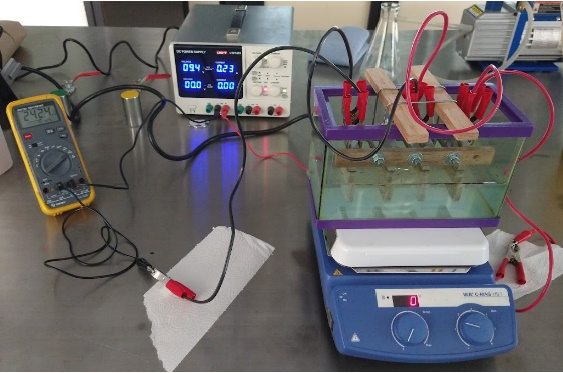- An, C., Huang, G., Yao, Y. & Zhao, S. (2017). Emerging usage of electrocoagulation technology for oil removal from watewater: A review. Science of the Total Environment, nº 579, pp. 537-556.
- Andrade, C. (2015). Propuesta de un plan de manejo sustentable de los aceites usados provenientes de los talleres automotrices y lubricadoras del Cantón Cañar. Available: https://dspace.ups.edu.ec/bitstream/123456789/7683/1/UPS-CT004544.pdf .
- Changmai, M., Pasawan, M. & Purkait, M. (2019).Treatment of oily wastewater from drilling site using electrocoagulation followed by microfiltration. Separation and Purification Technoligy, vol. 210, pp. 463-472.
- Fong, W., Quiñonez, E. and Tejada, C. (2017). Physical-chemical characterization of spent engine oils for its recycling. Prospectiva 15(2), 135-144. http://dx.doi.org/10.15665/rp.v15i2.782 .
- Gobb, L., Nascimento, I., Muniz, E., Rocha, S. & Porto, P. (2018). Electrocoagulation with polarity switch for fast oil removal from oil in water emulsions. Journal of Environmental Management, vol. 213, p. 119-125.
- IKA. (2021). Guidelines for Cleaning Electrodes. Available at: https://www.ika.com/ika/pdf/flyer-catalog/202103_Electrasyn%202.0_cleaning%20electrodes_EN.pdf.
- Jurado, A. (2017). Contaminación y manejo de aceites lubricantes usados. Revista Valores. Universidad La Salle Available at: https://hoy.lasalle.mx/contaminacion-y-manejo-de-aceites-lubricantes-usados/#:~:text=aceite%20lubricante%20usado.-,Los%20aceites%20lubricantes%20usados%20(ALU)%20son%20considerados%20como%20residuos%20peligrosos,integral%20de%20Residuos%20(LGPGIR). Accessed: September 29, 2022.
- Morales, P. (2015). Tratamiento de agua Residual de Biodiésel por electrocoagulación. Tesis de Licenciatura en Ingeniería Química Industrial, Instituto Politécnico Nacional, México.
- Morales, S. (2018). Remoción de aceites y grasas de un efluente industrial del sector lácteo por electrocoagulación con electrodos de aluminio. Available: http://cybertesis.uni.edu.pe/bitstream/uni/16416/1/morales_qs.pdf.
- Moussa, D., El-Naas, M., Nasser, M. and Al-Marri, M. A comprehensive review of electrocoagulation for water treatment: Potentials and challenges. Journal of Environmental Management 30(186), 1-18. https://doi.org/10.1016/j.jenvman.2016.10.032
- Perozo, J. & y Abreu, R. (2017). Evaluación de la electrocoagulación en el tratamiento de agua potable. Available: https://www.redalyc.org/pdf/863/86351157005.pdf.
- Perren, W., Wojtasik, A. and Cai, Q. (2018). Removal of Microbeads form Wastewater Using Electrocoagulation. ACS Omega 3, 3357-3364. https://doi.org/10.1021/acsomega.7b02037
- Canul, M., et al. (2023). Biodegradation of crude oil present un wastewaters: evaluation of biosurfactant production and catechol 2,3 dioxygenase activity. Revista Mexicana de Ingeniería Química Vol. 22, No. 1 (2023) Bio2932. Available: https://doi.org/10.24275/rmiq/Bio2932
- Portal Automotriz. (2015). Lubricantes: el motor que impulsa a las industrias mexicanas. Available: https://www.portalautomotriz.com/noticias/proveedores/lubricantes-el-motor-que-impulsa-a-las-industrias-mexicanas.
- Quesada, E. (2021). Evaluación de la gestión de los residuos generados en los centros de servicio automotriz que realizan cambio de aceite en la provincia de Heredia, Costa Rica. Available: https://hdl.handle.net/2238/13301.
- Rodrigues, J., Merçon, F., Firmino, L., Andrade, A., Braz, P. and da Costa, M. (2015). Evaluation of electrocoagulation as pre-treatment of oil emulsions, followed by reverse osmosis. Journal of Water Process Engineering 8, 126-135. https://doi.org/10.1016/j.jwpe.2015.09.009
- Sanz, A. (no date). Lubricantes. Available: https://www.eii.uva.es/organica/qoi/tema-13.php.
- Tahreen, A., Jami, M., and Ali, F. (2020). Role of electrocoagulation in wastewater treatment: A developmental review. Journal of Water Process Engineering 37, 1-11. https://doi.org/10.1016/j.jwpe.2020.101440
- Medrano, Z., et al. (2022). Domestic wastewater treatment by electrocoagulation system using photovoltaic solar energy. Revista Mexicana de Ingeniería Química Vol. 21, No. 2 (2022) IA2809. Available: https://doi.org/10.24275/rmiq/IA2809
|

